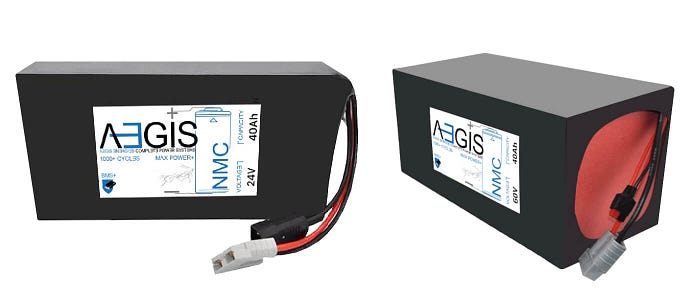Lithium Batteries — NMC vs LiFePO4
Today lithium batteries come in all shapes and sizes. However, some may not know there are different chemistries that make up the core internal battery.

For small consumer electronics like your cell phone, laptop or RC toy you often find Lithium Cobalt Oxide (LCO), Lithium Manganese Oxide (LMO), or Lithium Polymer Oxide (LiPo) chemistries.
However, for more demanding battery applications like electric vehicles, e-bikes, trolling motors, mobility scooters, solar storage, robots, etc. you will often need a chemistry that can provide larger amp hours and at higher voltages.

The first popular chemistry Nickel Manganese Cobalt (NMC) can be found powering EVs like Tesla to ebikes and trolling motors for one main reason. NMC can deliver power! NMC provides consistent high power and at large capacities compared to other chemistries that simply can not deliver high power rates.
A good battery supplier’s NMC battery should be able to consistently output 2–3C rate (charge/discharge rate) and last for 1000+ full cycles. For example, we routinely run full discharge tests to ensure our power delivery curve is performing correctly. Without fully testing the output at full discharge, you can not be sure your battery does not have faulty cells. For our battery packs, we test till the entire battery capacity is used, not just partial cycles like some sellers claiming to provide 10K+ cycles.
Another advantage of NMC is the relatively smaller battery pack size, due to each cell being 3.7 volts vs 3.3 volts in LiFePO4 cells. While this may not seem like much, once you start getting into larger capacity batteries (100Ah+), these can utilize 100–200+ cells, which take up more valuable space and add weight to whatever application it is powering.
Overall, NMC is a proven battery chemistry for high performance and energy density. This allows it to fulfill applications where size and space is limited but still requires high power and capacity.

The second very popular chemistry Lithium Iron Phosphate (LiFePO4) can be found in various applications like RV power to solar storage due to their high cycle life (3000+ full cycles) and extraordinary safety.
Due to iron phosphate crystal stability, LiFePO4 batteries can often be charged and discharged many times without much degradation compared to other chemistries that oxidate at high temperatures like LCO. Further, in many puncture or short-circuits tests did not create any fire or explosive events.
The drawback of LiFePO4 is the relatively small power delivery of 1–2C and at a less dense energy due to utilizing 3.2–3.3V cells. As mentioned, this starts to add up in size and weight for larger capacity batteries. For this reason, we generally recommend LiFePO4 for applications that might have thousands of partial cycle usage like RV back-up power, solar storage, power gates, etc and have no size or weight restrictions.
LiFePO4 continues to be one of the most popular choices for many people as it can often last 10+ years without much worry due to its high cycle life and inherent safety features.
To learn more about lithium NMC & LiFePO4 batteries, you can check out our battery specifications on our website www.aegisbattery.com
If you needed any help choosing the right battery for your application or had more questions, we are happy to assist. You can reach us anytime by email at contact@aegisbattery.com or call us 949–469–1776 during our business hours.

